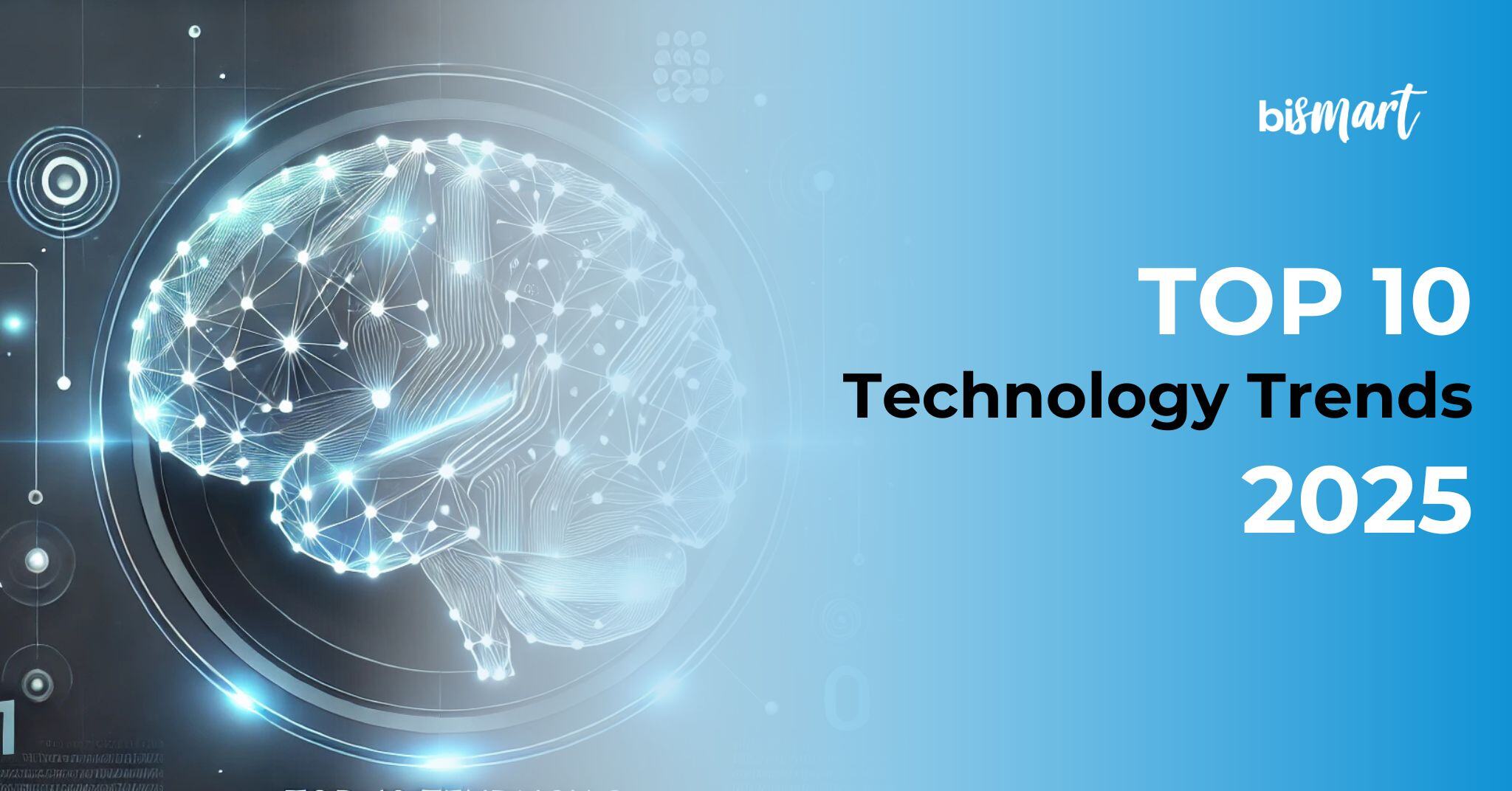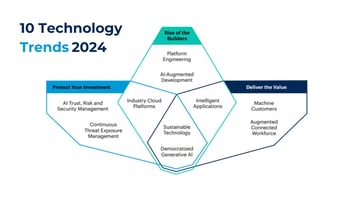Discover the top 10 technology trends for 2025 and how CIOs and IT leaders can address the challenges and opportunities they present.
All forecasts suggest that next year, technology will continue to transform not only the business landscape but also the way we interact with the world.
Are businesses prepared to face the challenges and seize the opportunities of this evolving landscape? Let’s explore the 10 technology trends set to define 2025.
The year 2025 promises to be a turning point for technology and business, marked by emerging trends that will redefine how companies operate.
In its latest report, Gartner has identified 10 technological trends that will steer organizations' strategies in 2025.
According to Gartner, these trends offer a roadmap designed to help IT leaders and CIOs make better-informed decisions.
These trends are grouped into three key areas: the challenges and opportunities of artificial intelligence, the new frontiers of computing, and the growing integration between humans and machines. Together, they outline a future where disruptive advances are intertwined with increasingly urgent ethical and social responsibilities.
For instance, artificial intelligence not only aims to optimize processes but also brings critical governance and security challenges, particularly in addressing the rising tide of misinformation.
For businesses, the challenge isn’t just adopting these technologies but understanding how to use them strategically, ethically, and sustainably.
The 10 Technology Trends That Will Shape 2025
1. Agentic AI
What is Agentic AI?
Agentic AI refers to artificial intelligence systems designed to act autonomously, making decisions and executing tasks without direct human intervention.
These systems integrate multiple AI techniques and capabilities such as memory, planning, environmental perception, tool usage, and adherence to safety protocols to operate independently. They can perceive their surroundings, reason, plan actions, and learn from experiences to adapt to new situations.

Why is it a trend?
The ability of Agentic AI to function autonomously or semi-autonomously has the potential to help CIOs realize their vision of generative AI by enhancing productivity across the organization.
- Gartner Prediction: By 2028, 15% of daily workplace decisions will be made autonomously by Agentic AI systems, compared to 0% in 2024.
Agentic AI: Use Cases
- Empowering workers to develop and manage more complex technical projects—ranging from micro-automations to large-scale initiatives—using natural language commands.
- Automating customer experiences by leveraging data analysis to make highly calculated decisions at every step of the journey.
- Transforming decision-making and enhancing situational awareness within organizations through faster data analysis and predictive intelligence.
2. AI Governance Platforms
What are AI Governance Platforms?
AI governance platforms are technological solutions designed to oversee, manage, and ensure the ethical and responsible use of AI systems within organizations.
These platforms provide capabilities for business leaders and users to evaluate, implement, and monitor governance policies, ensuring that AI systems operate transparently, fairly, and in compliance with current regulations.
Why are they trending?
Artificial intelligence is expanding across an increasing number of sectors, particularly in industries with stricter regulations. However, this growth comes with significant challenges, such as algorithmic bias, privacy concerns, and the rising demand for alignment with ethical principles and human values.
As these technologies become more deeply embedded in society, preventing negative impacts becomes essential. Responsibility in their development and application thus becomes a critical pillar.
- Gartner Prediction: By 2028, companies adopting AI governance platforms will see 30% greater trust from their customers and achieve a 25% improvement in regulatory compliance compared to their competitors.
AI Governance Platforms: Use Cases
- Identifying and mitigating risks associated with AI systems, including bias, privacy violations, and adverse societal impacts.
- Overseeing the governance process of AI models, ensuring that controls and approvals are adhered to at every stage of the model’s lifecycle.
- Continuously monitoring the performance and usage of AI systems, auditing their decision-making processes, and ensuring ongoing alignment with established governance standards.
3. Specialized Hardware
What is Specialized Hardware?
Specialized hardware are devices or components engineered to perform specific tasks with greater efficiency than general-purpose hardware. Unlike standard processors designed for a broad range of functions, specialized hardware is fine-tuned for targeted applications, delivering enhanced performance, lower energy consumption, and faster speeds.
Why is it trending?
For years, cloud computing has been viewed as an almost limitless resource. However, the industry is shifting towards a new era of resource optimization. In this context, hardware—long considered a diminishing strategic priority—is making a powerful comeback.
Specialized hardware is emerging as a critical enabler of growth in three pivotal areas of artificial intelligence: embedded AI and the Internet of Things (IoT), data centers, and advanced robotics.
Specialized Hardware: Use Cases
- Accelerating Artificial Intelligence (AI): Leveraging GPUs, TPUs, and ASICs to train and run machine learning and deep learning models faster. Applications include fraud detection, medical image analysis, and autonomous driving.
- High-Performance Data Centers: Deploying optimized hardware such as dedicated processors and advanced cooling systems to handle massive data volumes efficiently. These systems power cloud services, large-scale analytics, and streaming platforms.
- IoT and Smart Devices: Embedding specialized chips in connected devices—like industrial sensors or smart appliances—to process data locally, minimize latency, and boost device autonomy.
4. Small Language Models (SLM)
What are Small Language Models?
Small Language Models (SLM) are natural language models specifically designed to operate with limited computational resources. Unlike their larger counterparts, Large Language Models (LLM), SLMs prioritize efficiency in size, speed, and energy consumption without significantly compromising their ability to handle specific natural language processing (NLP) tasks.
Why is it trending?
Small Language Models are gaining traction in the artificial intelligence landscape for their ability to deliver targeted, cost-effective solutions. Unlike Large Language Models LLMs, which require extensive resources to function, SLMs are purpose-built to tackle specific problems while using fewer data and computational power.
This shift reflects a practical need to optimize existing tasks. For instance, instead of deploying a massive model to summarize reports or manage inventory queries, companies can train an SLM on curated datasets to provide precise, rapid responses, saving both time and resources.
Another key advantage is their ability to run locally, enhancing privacy and reducing reliance on cloud infrastructure. Leading players like Microsoft, Meta, and Mistral are at the forefront of developing smaller, more accessible models, highlighting that efficiency and customization are driving the next phase of AI evolution.
- According to a recent Databricks report, over 75% of organizations are already adopting open-source small language models, tailoring them to address specific use cases.
Small Language Models: Use Cases
- Efficient Internal Support: Train an SLM on a company’s internal data to quickly answer queries about policies, inventory, or procedures, eliminating the need for manual searches through extensive databases.
- Optimizing Specialized Operations: Deploy SLMs for tasks like maintenance or logistics data analysis, identifying patterns and optimizing processes with greater precision and cost-effectiveness.
- Personalized Customer Assistance: Use an SLM customized to a company’s products and services to provide instant, context-aware responses in chatbots or automated customer support systems.
5. Multimodal Models
What are multimodal models?
Multimodal models are AI systems capable of processing and generating information across multiple mediums, such as text, images, video, and sound. Unlike traditional models that focus on a single data type, multimodal models integrate various forms of communication to emulate human-like interactions.
Why is it trending?
The rise of multimodal models is driven by the increasing need for businesses to handle and produce information across multiple formats. Their ability to deliver versatile solutions tailored to diverse media makes them an efficient tool for addressing complex commercial challenges.
The 2024 release of tools like OpenAI’s GPT-4 Omni, Google’s Project Astra, and AWS’s Titan has marked a significant milestone in generative multimodal AI, capturing market attention. These advancements promise AI systems that can be trained once and operate seamlessly across formats, streamlining processes like rapid translations, content creation, and combined data analysis from sensors and images—key for industries like supply chain management.
- Deloitte’s Prediction: While generative multimodal AI shows immense potential, its progress may be gradual due to the significantly higher demands for data, resources, and hardware.
Multimodal Models: Key Use Cases
- Advanced Healthcare: Analyze X-ray images alongside clinical notes to detect anomalies and generate comprehensive medical reports that combine text and explanatory visuals for healthcare professionals.
- Supply Chain Optimization: Process data from sensors, inventory images, and logistics records to identify patterns, predict restocking needs, and optimize storage strategies.
- Personalized Marketing: Create campaigns that combine text, images, and videos tailored to individual customer profiles, automatically translating materials into multiple languages and adapting them culturally for different markets.
6. Edge Computing
What is Edge Computing?
Edge computing is a computing model that processes data closer to where it is generated or consumed, rather than relying solely on centralized data centers or the cloud.
This approach analyzes and processes data on local devices or nearby nodes, reducing latency, improving efficiency, and optimizing bandwidth usage.
Why is it trending?
Edge computing is gaining momentum by moving data processing closer to the devices that generate it, decreasing reliance on cloud infrastructure.
The integration of AI into PCs and smartphones—spearheaded by companies like Apple, Microsoft, and HP—is accelerating this shift. Meanwhile, businesses are adopting hybrid strategies to balance costs, performance, and privacy.
Far from being just an emerging trend, edge computing addresses pressing market demands with practical, scalable solutions.
- Deloitte’s Prediction: By 2025, more than 50% of data could be generated by edge devices.
Edge Computing: Use Cases
- Supply Chain Management: Process IoT sensor data in warehouses and logistics hubs to optimize inventory tracking, predict restocking needs, and reduce transportation times without cloud dependency.
- Industrial Monitoring: Enable real-time analytics in factories to detect machine anomalies, predict failures, and streamline maintenance, minimizing downtime and operational costs.
- Smart Retail: Use edge devices at points of sale to personalize customer experiences, analyze shopping behavior, and manage inventory in real time, boosting efficiency without overloading central infrastructure.
- Financial Services: Process data locally at ATMs or branch locations to speed up transactions, detect fraud in real-time, and ensure service continuity in areas with limited connectivity.
- Critical Infrastructure: In energy and telecommunications, analyze data at remote stations or substations to optimize resource distribution and respond swiftly to issues, ensuring safe and uninterrupted operations.
7. Spatial Computing
What is Spatial Computing?
Spatial computing transforms the physical world by integrating digital content directly into real environments, enabling users to interact with it in an immersive, realistic, and natural way.
Why is it trending?
Spatial computing is gaining momentum thanks to advancements in technologies such as augmented reality (AR), mixed reality (MR), and artificial intelligence. These innovations enable immersive digital experiences in industries like gaming, healthcare, and e-commerce.
The adoption of 5G, along with groundbreaking devices like Apple Vision Pro and Meta Quest 3, is driving consumer interest and opening up opportunities for new business models.
Additionally, with major players like Nvidia and Qualcomm spearheading the development of technological ecosystems, the market is projected to grow from $110 billion in 2023 to $1.7 trillion by 2033.
- Gartner Prediction: By 2028, 20% of people are expected to interact weekly with geopositioned, persistently anchored immersive content—a significant leap from less than 1% in 2023.
Spatial Computing: Use Cases
- Collaborating in immersive 3D environments: Transform remote meetings into more interactive and dynamic experiences, enhancing communication and teamwork effectiveness.
- Designing realistic simulations for employee training: Create practical learning experiences that reduce costs and risks while improving skill acquisition and retention.
- Enhancing the shopping experience with virtual assistants: Allow users to explore stores and make purchase decisions guided by interactive assistants, boosting engagement and driving sales.
8. Hybrid Computing
What is Hybrid Computing?
Hybrid computing integrates multiple technologies—such as CPUs, GPUs, edge devices, ASICs, and neuromorphic, quantum, and photonic systems—to address complex computational challenges.
This approach combines the unique capabilities of each technology within a unified environment, maximizing their strengths and optimizing overall performance.

Why is it trending?
Hybrid computing enables companies to adopt emerging technologies, such as photonic, bioinformatic, neuromorphic, and quantum systems, to create transformative impacts on their operations.
A prominent example is generative artificial intelligence, which requires advanced computational, networking, and large-scale storage capabilities to solve complex problems efficiently and accurately.
Hybrid Computing: Use Cases
- Efficient scalability: Manage critical workloads on in-house infrastructure to ensure security, while leveraging the cloud to handle demand spikes during periods of high activity.
- Enhancing security and compliance: Store sensitive data on-premises to comply with strict privacy regulations, using the cloud exclusively for less critical operations or data analysis.
- Driving innovation and development: Employ cloud-based development tools to accelerate processes while maintaining secure, on-premises environments for final production.
9. Energy-Efficient Computing
What is Energy-Efficient Computing?
Energy-efficient computing, also known as green computing, focuses on designing, developing, and using computing systems that minimize energy consumption and reduce environmental impact.
This approach aims to optimize the use of technological resources to lower the carbon footprint and promote sustainability in the information technology sector.

Why is it trending?
Sustainability has become a top priority for corporate boards.
The IT sector has a significant environmental footprint, particularly in industries like financial services and technology, due to the high energy consumption of technologies such as artificial intelligence.
As improvements in traditional processing systems approach their limits, emerging technologies like graphics processing units (GPUs), neuromorphic computing, and quantum computing are expected to deliver substantial advances in energy efficiency over the next five to ten years.
- Gartner Prediction: Reducing their carbon footprint is the primary concern for most IT organizations today.
Energy-Efficient Computing: Use Cases
- Optimizing data center operational costs by reducing energy consumption in both servers and cooling systems.
- Designing sustainable products using energy-efficient computing technologies to minimize power consumption.
- Integrating intelligent energy management systems to decrease electricity usage in corporate networks and offices.
10. Disinformation Security
What is Disinformation Security?
Disinformation security focuses on ensuring the reliability and authenticity of information circulating in digital environments.
Its primary aim is to develop systems capable of identifying trustworthy content, verifying its accuracy, and preventing attempts at identity fraud or the creation of manipulated information.
This also involves actively monitoring the spread of harmful content to mitigate its impact on society, organizations, and critical processes.

Why is it trending?
Disinformation has become a digital arms race. Malicious actors are exploiting tactics such as phishing, hacktivism, fake news dissemination, and social engineering to create chaos, instill fear, and perpetrate fraud.
With advancements and the increasing accessibility of technologies like artificial intelligence and deep learning, targeted disinformation attacks against businesses are on the rise. These represent persistent, high-impact threats that require effective management.
- Gartner Prediction: By 2028, 50% of companies are expected to incorporate products, services, or features specifically designed to address challenges related to disinformation security—a significant leap from less than 5% in 2024.
Disinformation Security: Use Cases
- Detecting synthetic media usage in authorized contexts, such as identity verification, real-time communications, or claims validation.
- Monitoring narratives spread across mass media and social networks, particularly those targeting executives, products, services, or brands.
- Preventing identity impersonation of individuals connected to an organization, including employees, contractors, suppliers, and customers.
Conclusion
The year 2025 is shaping up to be a period of unprecedented technological transformation, where businesses must adapt quickly to an ever-evolving landscape.
The trends identified by Gartner not only provide a glimpse into the future but also emphasize the importance of a strategic and ethical adoption of these innovations.
From agentic artificial intelligence to neurological enhancement, each trend presents both opportunities and challenges that organizations must address with responsibility and foresight.
The key to success will lie in a company’s ability to integrate these technologies in ways that drive efficiency, foster sustainability, and build trust in an increasingly digital world.
By preparing for this future, organizations will not only secure their relevance but also contribute to a more equitable and secure technological ecosystem.



